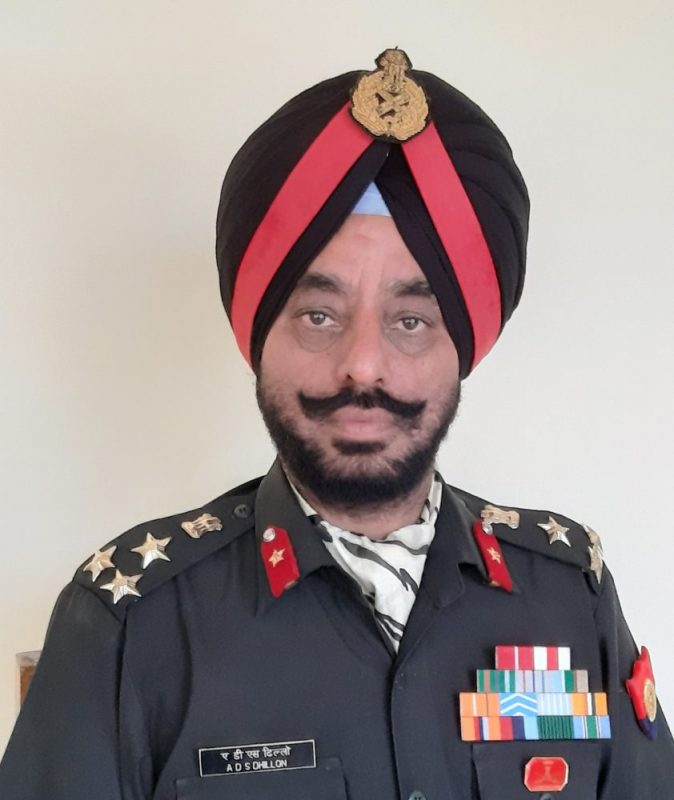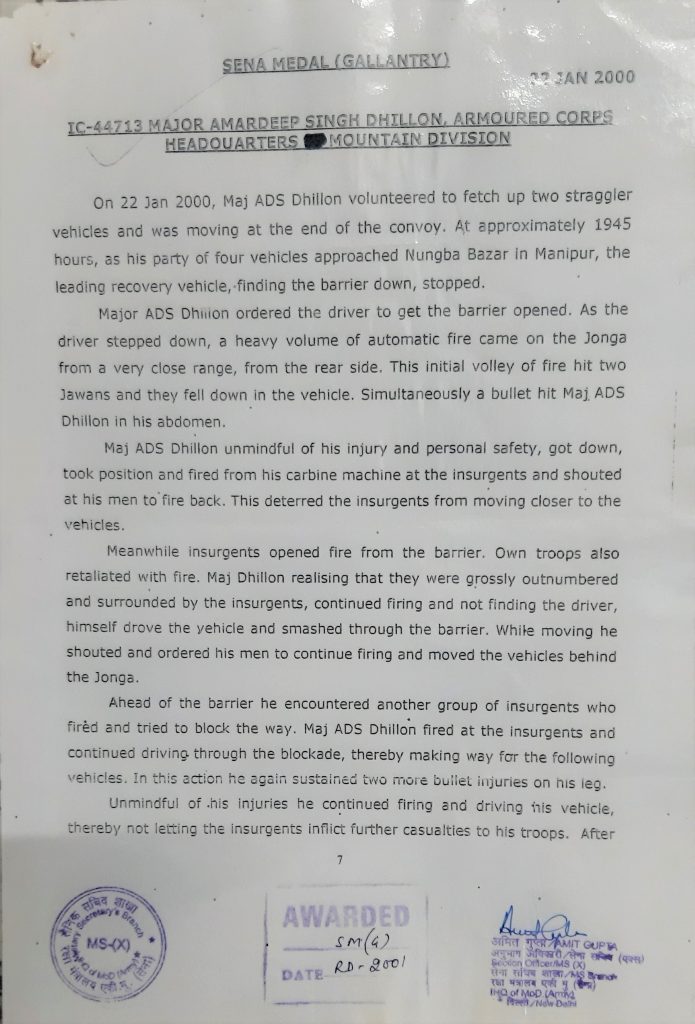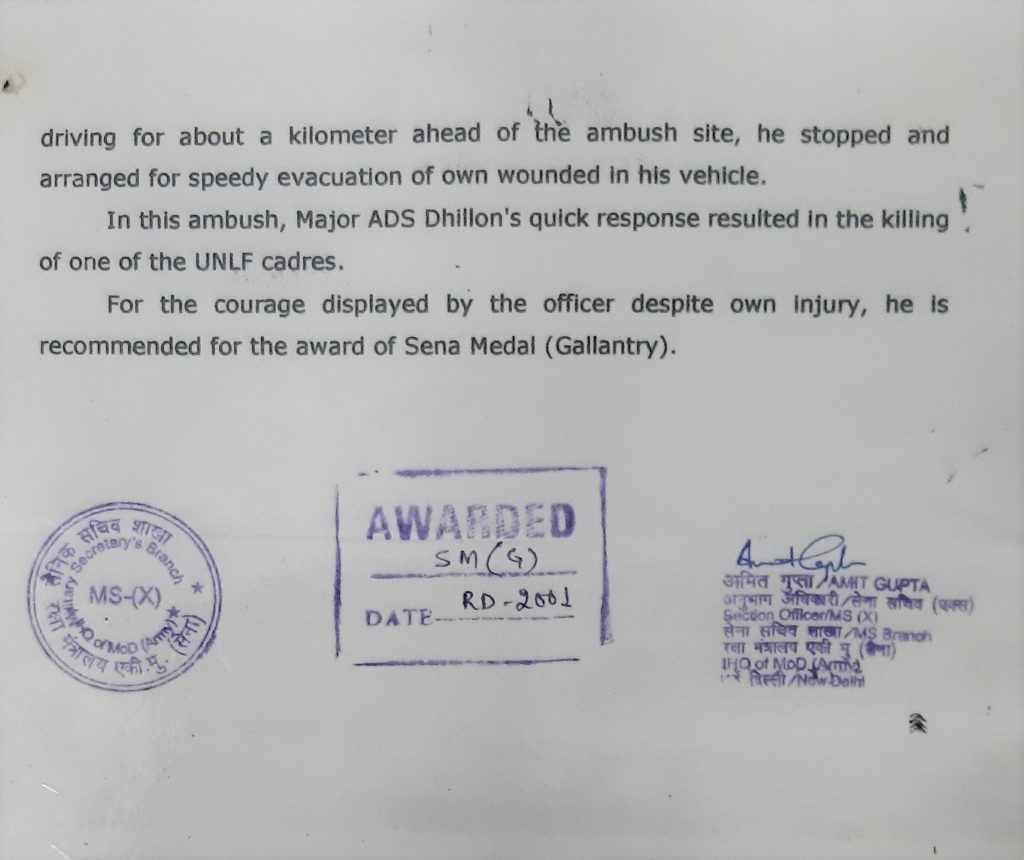
The Great Escape
Email from Brig Amardeep Singh (J-381,1982)
From: amardeep singh
<amardeep90ar@gmail.com>
Date: Tue, 23 Jun 2020, 22:59
Subject: Fighting through ambush by Amardeep Singh Dhillon ,
To: < jashanjot@yahoo.com>
Good Evening Sir,
It was honour receiving your call today.
Brief sketch
I am Amardeep Singh Dhillon, from Village Bandi in Bathinda District. I belong to a farming family and the only child of my parents.
I joined The PPS in Mar 1974 on Punjab Govt Scholarship (J 381). I was an average student throughout. I did participate in Swimming etc. After passing out in 1982 (12th, ISC), I did my College from Khalsa College, Sri Ganganagar. I did MSc 1st year from the same college. In Jan 1986 I joined IMA and passed out in June 1987.
I got Commissioned to 10 Armoured Regt and served at various places, Samba, Lalgarh Jattan (Sri Ganganagar) thrice, Jalandhar, Kupwara sector, Amritsar, Wellington, Manipur, Lebanon, Jhansi, Kanpur, Faizabad, Mhow, Bikaner, Delhi, Allahabad. I held various staff and command appointments,
I have commanded 90 Armoured Regiment, 8 Infantry Bde, President of Selection Board.
I have also been awarded with Sena Medal Gallantry and Army Commander’s Commendation card for carrying out Rail rescue operation in 2010.
The details of my account of Fighting through Ambush and the Citation are attached. I will try to send my School Photo soon.
Since I was on UN mission at the time of award of Sena Medal, I don’t have any photo of that.
With warm regards
Amardeep
____________________________________________________________________________________________________________________________________
(From The Eagle, 2002)
‘The Eagle’ is proud of Maj. Amardeep Singh Dhillon’s (J-381) PPS (74-82) bravery and the ONA wishes and prays for his speedy recovery.
After doing Staff College Course (97-98) Maj. Amardeep was posted as GSO 2(Ops), HQ 57 Mtn. Div. On 22-01-2K, while fighting militants he sustained numerous gunshots wounds i.e. a burst in left leg, another in stomach and another in the shoulder.
Since 30-01-2K, Maj. Amardeep is in Research and Referal Hosp., New Delhi. He still has to undergo a few more operations and around Oct. 2000 is likely to be shifted to Offrs’ Surg. Ward, Base Hosp., Delhi Cantt.
Postal Address till March 2001: Permanent
C/o. Flt. Lt. Prabjeet Singh , VPO Bandi
SP 231/2, Subroto Pa,rk Distt. Bhatinda – 151401
New Delhi Tel.: 0164-42281
Tel.: 5694549 (not relevant now)
(This was added in The Eagle, 2007)
Now Col, Staff, Sena medal, 90 Amd(10)
__________________________________________________________________________________________________________________________________
( The point by point story of the Escape as narrated by Brig Amardeep himself.)
SURVIVED TO TELL THE STORY
An Ambush in Manipur: Breaking Through & Surviving
Purpose
Emphasising the play of psychological and behavioural factors in adverse situations, and how they can be overcome, through a narrative of personal experiences.
Background
I was posted as a staff officer at Division Headquarters in Manipur (Leimakhong) after my course at Defence Services Staff College (DSSC) in July 1998. The Division moved to its permanent location in Silchar, South Assam in Nov 1999 after the Kargil war. In Jan 2000, the Division was again deployed in Manipur in CI grid for the general election.
The Ambush
Teething Troubles
- After a detailed briefing regarding the movement of Division and elections, a convoy of about 50 vehicles and 2 protection vehicles moved out of Silchar at 0100 hrs on 20th January 2000.
- There were 3 officers in the convoy – one in the lead, another in the centre, and I was bringing in the rear (in a covered Jonga).
- Within the first few kilometres, one protection vehicle (PV) broke down. After unsuccessful attempts at repairing it, the PV had to be towed by a recovery vehicle.
- Another hour later, a 3-ton vehicle broke down. Since , there was just one recovery vehicle, the 3 ton was towed by the recovery vehicle, and the PV was towed by another vehicle.
- By this time, communication at the rear of the convoy had broken with the leading vehicle, due to distance covered, as well as the mountainous terrain.
- The movement of this detached, rear portion of the convoy was very slow, due to the 2 vehicles being towed. There were further problems – the front wheels of the 3-ton vehicle being towed came off, and further on, towed vehicles got stuck on a bridge at a U-bend. These unforeseen impediments led to 7 vehicles being completed detached from the main convoy.
- The main convoy reached their designated destination by 1600 hrs and reported the same to Division Headquarters. However, our detachment was still far away.
The Fight
- At approximately 1900 hrs, our detachment (comprising of two 3-ton vehicles, recovery vehicle, three off road 3-ton vehicles and my Jonga) reached the village of Nungba.
- Since it was dark, and we were on a new route, we halted at the village centre, where 3 ladies were standing. The driver of my Jonga asked them about the route, and one of the ladies indicated the direction by lifting her arm.
- The moment she indicated, there was a quick sound of firing.
- It happened so quickly that I couldn’t fathom what it was, until my buddy shouted “Saab, goli lag gai”
- That is the time I realised that it was an Ambush. And my first thought was – what reply will I give to Corps HQ, when asked about an Ambush in the middle of the village. However, I quickly cast that thought aside, and got down to addressing the firing, which sounded like it was from rear of the vehicle.
- I immediately cocked my carbine, twisted in my seat and fired back through the window. This might have taken approximately 4-5 seconds, and immediately upon my retaliatory firing, the firing reduced.
- After a few seconds, I realized that I had been hit on right side of abdomen. Upon touching that area, my hand felt wet and warm. I shrugged off the hit as nothing to worry about, since the injury was in the thick of muscles, and not a cause for concern. And so, I continued with my retaliatory firing.
- By this time, firing from the ambush had reduced, almost stopped.
- I called to the driver, Kalayan, to move out of the ambush area, but received no response. I turned around to see that the driver was not in his seat and his door was ajar. I again shouted for him, but there was no response.
- By now, the remaining three occupants of the Jonga (my Manipuri buddy, radio operator and myself) were all injured, and the driver was nowhere in sight. My magazine also now empty.
- In this region, after ambushing, the insurgents come to the survivors, and chop off limbs for any valuables and weapons.
- Realizing the gravity of the situation, I quickly filled in about 10-12 rounds in the magazine, moved to the driver’s seat and shouted for Kalayan one last time. Receiving no response, I assumed he had taken shelter.
- As I tried starting the Jonga, my injured buddy sitting in the rear seat picked up the rifle and fired through the roof. Realizing that he was not completely stable at the point, I took his weapon and kept it on the front seat, and told him to sit back and relax.
- I started my vehicle and inched the Jonga towards the other vehicles in the detachment. As I moved past these vehicles, I directed the men to give retaliatory fire and move out of the area (there had been no retaliatory firing in the initial ambush firing from these vehicles).
- As crossed the other vehicles, I saw that the road was blocked by a barrier and a Forest check post. Since I saw no one manning the barrier, I accelerated and rammed through it. This broke the barrier, and I continued onwards.
- I would have gone only about 80-100 yards when the insurgents began firing again, this time from the front of the vehicle. This time, I got a bullet burst on my left shin bone, and it was very painful.
- Since the firing was from the front, the wind shield was shattered, the headlights went out and the vehicle was close to a road bend.
- With vengeance and anger, I pulled out my carbine through the right-side window and fired back.
- Again, as soon as I fired back, theirs stopped. It was later learnt that at this point, one insurgent was killed, and another was injured.
Survival
- Once the firing stopped, I immediately tried to start the Jonga. Fortunately, it started. As soon as it moved, I realized that the left rear wheel had burst. But I continued nonetheless.
- The windshield, being completely shattered, did little for the visibility. I drove the vehicle by navigating what little I could see from the side windows.
- After going some distance, I stopped the vehicle and tried to make a hole in the windshield using the butt of my carbine. The moment I hit for the first time, I realized that I had done something foolish, because carbines are incredibly sensitive guns, and hitting their butts usually lead them to fire. Thankfully, the carbine was empty, else the remaining bullets would have gone through me head.
- With great difficulty, I made a small hole in the shattered screen. And I continued to move on the hilly road in pitch darkness of the forest.
- After some time, I saw a light coming from the opposite direction. Having just survived an ambush, I was not sure if the vehicle belonged to the insurgents or others. But as it came closer, I saw that it had markings of SDO on it.
- I swung my Jonga towards the vehicle and waved it to stop. The vehicle stopped and the SDO came up to me. I told him that militants had fired on my convoy at the village Nungba. He replied that he was the SDO of Nungba and had gone to District HQs but got delayed and may not be able to help as he was already late.
- Annoyed by presumptuous attitude, I just raised my carbine and told him that he might be late for life. Immediately the gentleman apologized and said that he knew Maj Chouhan at Khongsang, and he would escort us there.
- He called his staff and directed them to help us. That’s when I found out that my radio operator had died. The staff came and lifted my buddy to their vehicle, but did not return, assuming I was fine.
- I then got out of the vehicle, stood on one leg, ensured that all documents, radio sets and a brief case full of computer hard discs were moved to SDO’s vehicle. At the time my prime concern was safety of those hard discs full of sensitive information, the loss of which would have been very shameful for the Army.
- But while this transfer was happening, I started to feel dizzy, presumably from loss of blood. I just prayed to God for strength to fight back. I lowered my head, and after a while it was OK.
- As the staff was moving all the equipment to the SDO’s Gypsy, I mentally analysed the injuries. I presumed that the bullet in stomach had gone through muscles, so it will be stitched up and OK to go in 15 days. As far as leg was concerned, it was shattered, so would probably require to operated upon and steel plate to be fitted. Would take 3 months to heal, so no problem – I would relax in hospital and recover fast.
- Then I hopped over to the Gypsy with the staffs’ support. On sitting, I asked them for my water bottle and had some water. No first aid was administered by SDO or his staff – they themselves were shell shocked. We made our way to Khongsang in silence, while I closed my eyes and rested.
- We reached the post in about one hour. On reaching, I briefed Maj Chouhan about the entire incident. I was then taken to a makeshift MI room shelter.
- The nursing assistant informed me that my buddy was more severely injured, so I directed him to treat him first. As they were treating him, I asked a jawan to get tea for me.
- A few minutes into the treatment, the nursing assistant showed me bullet and mentioned that it was from my shoulder. It was only then I realized that I had a bullet in my shoulder also. I just took the bullet and put it in my jacket’s pocket.
- After some basic First Aid, I was put in a 3 Ton with a bed and my buddy in a second vehicle, and we moved in the night-time only. Halfway, at Battalion HQs, the Commanding Officer and the Doctor came to see me. The Doctor tried to administer glucose, but it didn’t work. I reassured them that I was fine.
- They then shifted me to a 1-ton Ambulance, but that stopped within 2-3 kilometres. I was again shifted back to security vehicle. We moved throughout the night.
- At first light, I could hear helicopters flying above us, but due to heavy fog, they couldn’t help us.
- We reached Leimakhong’s Military Hospital (MH) at about 0800 hrs. On reaching, I explained the incident to two officers of Divisional HQs.
- Luckily, a surgeon had come on TD from Jakhama, and he operated on me, after my de briefing.
- My wife came to the hospital after 3 days to take care of me. After 8-9 days, I was transferred to Research & Referral (R&R) Hospital, New Delhi. I was again operated upon reaching there, as my stitches on my intestines had opened on the flight from Imphal to Delhi.
- Colostomy was done and I was on DI list for about 14 days. Thereafter, I was shifted to Base Hospital, to recover my leg. My leg was operated upon 2.5 months after the original incident. There, Illazarove was fitted on my left leg, with which my bone was grown by 1.5 inch.
- In the month of September, I was again operated at RR hospital to reset my intestine. Illazarove was removed in January 2001
- I was finally discharged after almost 15 months from Base hospital with two medical categories.
Flourishing
- Just want to highlight that the ambush was not limiting in any way in my life and service.
- On 26th January 2002, I was awarded with Sena Medal Gallantry.
- Commanded HQ Squadron with dual Category and on crutches during Op PRAKARAM.
- Went on to UN Mission as Staff officer at Lebanon.
- Held the appointment of AQ of Armd Division, Commanded Armd Regt and earned Unit Citation.
- As Dy Cdr of Inf Bde played a pivotal role in converting the bde to Armoured Bde.
- Commanded Inf Bde.
Highlights of the Case
- One militant was killed, and another was injured.
- Two Jawans were martyred.
- All-important document, computer hard discs were saved.
- Jonga received about 90 bullet marks including one on Petrol tank .
- I sustained burst on Left leg, burst on stomach, bullet in right shoulder, three bullets though my turban, and one bullet on my custom-made web belt D buckle.
- The driver sustained one bullet injury to the right shoulder.
- The incident became a Case Study at Insurgency Warfare School at Vairangte and Defence Services Staff College, Wellington.
- And by God’s grace, I survived to tell the story !
___________________________________________________________________________________________________________________________________________
The Citation

